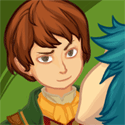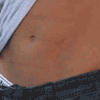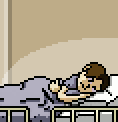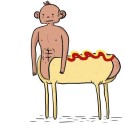|
No problem. If you check out some of the other art threads in here they have some great resources. You could try looking at/posting in the Let's Steal an Art Education thread if you want more info/feedback about various things, especially if you're feeling lost about some of the fundamental stuff.
|
|
|
|

|
| # ? Apr 24, 2024 01:04 |
|
Is there a thread about tablets (as in Wacom, not iPad) somewhere? Comparing the various brands, personal experiences, etc. I assumed it would be in this subforum, but I can't see anything that looks like it. wanna learn to draw EDIT: I found the Wacom thread on page 3 and also I am blind. Please post ideas to help the visually-impaired learn to draw :I Meningism fucked around with this message at 03:21 on Dec 1, 2011 |
|
|
|
If you want to learn to draw start with paper and a pencil. An $800 device isn't magically going to make you Picasso.
|
|
|
|
Ferrule posted:If you want to learn to draw start with paper and a pencil. Neither is paper and a pencil. 
|
|
|
|
Ferrule posted:If you want to learn to draw start with paper and a pencil. I do draw on paper; I just want to play with making things on a computer and not have to use a mouse 
|
|
|
|
I hope I'm in the correct thread for this question. Does anyone know who made these pieces?     I've been coming in and out of art for the past several years and I always seem to give up as I couldn't decide on a style I wanted to stick to. I think I just now want to come back, using these as inspiration. I want to know where to get more of them though. Anyone have any clues on the artist?
|
|
|
|
Well that very bottom panorama of a Sears is by Brandon Bird. I don't think the other ones are, though.
|
|
|
|
I'm trying to ltrack down the name of a painting before christmas, but I can't seem to find it. I saw it in Munich about two years ago and I believe it was in the Neue Pinakothek. If I remember it correctly the painting was called "Der Uberhund" and it may have been done by a german realist. The painting is of a black dog in front of a black background. Google has been useless and the Neue Pinakothek's website has been little help. Are there any resources that I can use to try and find it?
|
|
|
|
Meningism posted:I do draw on paper; I just want to play with making things on a computer and not have to use a mouse Well, you made it sound like you want to learn to draw, so sorry about that. I use an Wacom Intous3. 9x12. I like the larger size. The newer Intous4 at the same size will run you about $470. Go smaller if you don't have the cash. Avoid the Cintique for now, it's expensive and, frankly, isn't going to help you develop the digital drawing skill you're looking for. Also avoid Wacom's new Inkling product . I've been told by many a professional that it's buggy. Once you get a tablet the best way to learn the control is to play solitaire (or some simple game). It'll let you get a feel for using the stylus/breaking your mouse habits. Then just gently caress around in Photoshop/Manga Studio (super-cheap, nice drawing program despite the horseshit name) to gain the feel of sensitivity, gesture, etc.
|
|
|
|
Is there a way to rasterbate in photoshop? I want to break a five-foot image down to 8x11 slices but retain the transparent properties of the background so I can print them onto transparencies.
|
|
|
|
Imapanda posted:I hope I'm in the correct thread for this question. http://www.artslant.com/global/artists/rackroom/16237 I used TinEye to find that Soopafly posted:I work in a science lab and we go through about 3 dozen of these things a week, and they're kinda cool but I haven't found anything interesting to do with them yet. Ideas? have a look at peter wegner, http://peterwegner.com/?pa=/works/installation/&gid=77&sl=720 Beat. fucked around with this message at 00:28 on Dec 13, 2011 |
|
|
|
I'm tired to poo poo of not knowing anatomy. What's the best way to study it in order to shove that info in my brain so I can go onto bigger and better things? Should I just copy the illustrations in anatomy textbooks?
|
|
|
|
Humboldt squid posted:I'm tired to poo poo of not knowing anatomy. What's the best way to study it in order to shove that info in my brain so I can go onto bigger and better things? (note: my perspective is still that of a relatively new student, so take it with a grain of salt.) Anatomy comes in three parts: 1. Understand what the parts are. 2. Understand how the parts connect and interact. 3. Understand how the parts vary. I see a lot of artists get tripped up at pretty much every step. Some artists get 3 and have a lot of variation in their characters, but never studied 1 and so their basic anatomy is still off. (My favorite here is the "really strong" characters with 12-pack abs. In my experience, you're going to study anatomy in two chunks: 1/2 and 2/3. Study 1/2 by drawing from anatomy books. This helps you know what's under the skin and how it fits together - what bones go where, where muscles connect and how they behave, etc, what sizes different parts are (how long is the femur compared to the ulna and radius? etc.). You obviously don't need to know this as well as, say, a medical student would, but cover the basics. Study 2/3 by drawing actual people, either live-drawing or through tools like Pixelovely's drawing classes. This helps you recognize the variety of ways in which the basic pieces can be shaped (some people have short thighs and long arms, some people are very tall but thin, and we all know how variant faces can be!) and helps you recognize the limits of the pieces (for example: how far can the average wrist joint bend?). You don't necessarily have to do it in that order, although you will, I think, discover that if you study 1/2 first, your 2/3 drawings will become more accurate and detailed. I hope that helps and isn't just hopelessly wrong. 
|
|
|
|
I think you have to keep yourself grounded in life drawing when you study anatomy, or you will end up with really unnatural forced stuff. Like, people learn to draw particular muscles, and then they put those muscles into their figures whether they belong there or not. "Anatomy" largely derives from the pose. Anatomical features appear and disappear according to the pose. Even if the anatomy is "correct," to draw a form which wouldn't stick out that much in a certain pose is worse than not drawing the form. When I took anatomy drawing courses in college, we had a short lecture at the beginning of each class to focus on one particular body part (upper leg/lower leg, etc), and then did an hour and a half or so of drawings from nude models. Learning about the muscular forms was useful for clearing up the question, "What am I looking at, here?" But it's so specific, varies so much between men and women, can be totally obscured by body fat and clothing, and relies so much on the pose, that I don't think there's a way to "study" it outside of a dense context.
|
|
|
|
What do you folks think about tracing guidelines from a photograph? (I don't know if there's a term from this.) I'm not talking about going over it and drawing outlines around everything, but let's say you're sketching a photo of a person. You trace a rectangle around the head, then use that rectangle as a reference to get the rest of your drawing (done in freehand) proportioned correctly. Is that "cheating"? I know it's not unusual for artists to measure things, but maybe that's taking it too far? It's hard to tell. As a newbie, it kind of feels like any sort of measuring is cheating, because it seems logical that the best way to train your eyes is to use your eyes and nothing else. I still draw most things purely freehand anyway, so I'm not exactly worried about hindering myself. I just wonder if I'm wasting my time on the odd occasion that I don't.
|
|
|
|
Humboldt squid posted:I'm tired to poo poo of not knowing anatomy. What's the best way to study it in order to shove that info in my brain so I can go onto bigger and better things? I got a lot better at anatomy after taking a class at my college. Besesoth and neonnoodle basically got it; most of what we did were gesture drawings for the entire class period (2.5 hours) plus filling up some sketchbooks to turn in as homework. You could do live nude model sessions or use online tools like pixelovely and posemaniacs, just make sure you're doing a lot of it every day. My professor also gave us some free anatomy books in PDF form, which I thought were extremely helpful. All I did really was copy the illustrations out of them. Figure Drawing For All It's Worth by Andrew Loomis is my favorite, and you can find it for free online. These should also be free, but if you can't find them I'd be happy to send you the PDFs: See, Feel, Trace, Draw It by Sheldon Borenstein - also very helpful Dynamic Wrinkles and Drapery by Burne Hogarth Dynamic Figure Drawing by Burne Hogarth Drawing Dynamic Hands by Burne Hogarth Strength Training Anatomy 2nd Edition by Frederic Delavier - kind of weird, but could still help Didja Redo posted:What do you folks think about tracing guidelines from a photograph? (I don't know if there's a term from this.) Nah, you're fine. I mean, all you're doing is just using the head as a tool for measuring the rest of it; artists do that all the time, whether they're newbies or professionals. If anything, as a newbie you should be measuring, however far you take it. It's better that you have a good foundation in making sure your drawings don't suck than trying to avoid "cheating."
|
|
|
|
Humboldt squid posted:I'm tired to poo poo of not knowing anatomy. What's the best way to study it in order to shove that info in my brain so I can go onto bigger and better things? http://anatomyproartifex.blogspot.com/ As good as a textbook and it's free. It's done by an anatomy teacher/medical illustrator, and she's great at what she does. It's updated regularly, so just keep checking back for more and more info. She usually covers little quirks and variations within the posts.
|
|
|
|
My mom's asking me for Christmas present ideas, what do I ask for in the way of good graphic design books? I've got over two years work experience under my belt and I'm not sure what to ask for.
|
|
|
|
Jefferoo posted:My mom's asking me for Christmas present ideas, what do I ask for in the way of good graphic design books? I've got over two years work experience under my belt and I'm not sure what to ask for. http://www.thinkingforaliving.org/topics/shelf
|
|
|
|
Jefferoo posted:My mom's asking me for Christmas present ideas, what do I ask for in the way of good graphic design books? I've got over two years work experience under my belt and I'm not sure what to ask for. From the list raging bullwinkle posted, I'd like to specifically endorse Thinking with Type. It's a great typographic resource with straightforward explanations, charming writing, and great visual references. Also, if you have any interest in social commentary, The Design of Dissent is a great collection. Fair warning: it's from 2006, so it lacks images regarding the turmoil of recent years.
|
|
|
|
Seeking some help! Im a cartographer (making maps) working on some research on map reading and design and how different people understand "space". http://geography.uoregon.edu:50000/bentesting/quiz/quiz.swf Im a master's student at the University of Oregon. I need some participants to take this quiz. It involves some personality questions and then some map orientation questions. Should take about 10 minutes. **Im sorry if this is not a good place for this, Im not trying to poo poo up this thread. I put it in the SAL topic too, but think it applies more to this crowd. Zevo fucked around with this message at 04:54 on Dec 22, 2011 |
|
|
|
Zevo posted:Seeking some help! Im a cartographer (making maps) working on some research on map reading and design and how different people understand "space". Your link doesn't work! Anywhere! It's abbreviated in the middle (see the ellipsis?)
|
|
|
|
Good call. Fixed that! Should work now.
|
|
|
|
Zevo posted:Good call. Fixed that! Should work now. Cool, filled it out. Couple notes for any potential future quizzes:
|
|
|
|
I recently got into Hama/Perler beads as a way of making neat little gifts for people that don't cost a whole lot. Sprite-art and the like, it's working pretty well. Then I go on Google looking for what other people have done and I see people posting goddamn 3d bead models of Gameboys, the A-Team van, all sorts of awesome junk, like this: However, it seems nearly impossible to find the patterns for these, so I was wondering if anyone had any decent resources for things like this?
|
|
|
|
Hey guys. Long time lurker, like... second time poster here. Not entirely certain this is a good question for this thread, but I don't know where the hell else to ask it. I got to a point in my novel where somebody shoots at the main character with one of those very early pistols with a fuse on the back. So, what the hell would a lead musket ball do upon hitting an old, decrepit stone and mortar wall? Kind of a trifling detail, but it's an important moment in the story and I want to describe it correctly. -Shockingly-, finding an answer to this question is positively vexing. I'm thinking it just sorta slaps into the wall and flattens, knocking a small spray of some of the mortar lose. Would it ricochet, though? Would it smash out some chips of stone? I wanted some of this to hit the protagonist in the face, initially. Anyway, whatever. Any thought on any of that would be useful. Thanks.
|
|
|
|
Ramivacation posted:So, what the hell would a lead musket ball do upon hitting an old, decrepit stone and mortar wall? Interesting question! You'll probably get a far more accurate answer (and a way more knowledgeable userbase) if you try asking it in TFR's General Questions thread.
|
|
|
|
Perfect. Thanks, Pipes!
|
|
|
|
Okay, so I'm really interested in drawing comics at print size because that's about the size I usually draw anyway, and because I'm cheap and that means all I have to do is cut down standard printer paper. The size of a standard comic book page, full bleed, is 6.875 x 10.5 inches. Full bleed means that this is what the page looks like before having an eighth of an inch chopped off at every side. The live area (the boundaries of which are the same as the outer edges of panels) is 6 x 9 and important artwork and dialogue should be kept mostly within this area. The overwhelming majority of artists work at a size much larger than print size, which is naturally shrunk down in the printing process. I can only think of two artists who draw at print size, and one of them does not draw very detailed comics to begin with. The other artist is Art Spiegelman of Maus fame. Does anybody else know of any other comic book illustrators who draw at print size?
|
|
|
|
Photoshop question that I feel there should be a really dumb, obvious answer to: When digital painting/drawing, what's the easiest way to keep your reference photo always on top and in view? Or alternatively, how can I prevent Photoshop from constantly resizing and reshaping the window I'm working in when I zoom and move around? It gets annoying to constantly have to Cmd-Tab back to my ref photo just because I want to zoom in on a part of my work.
|
|
|
|
Not sure about keeping an image on top of your current window at all times, but you can prevent the automatic resizing of images by going to preferences -> general and unchecking the "zoom resizes window" option. There's actually a lot of really interesting options in there if you poke around. I also like to turn off "open documents as tabs" and "allow floating document window docking," that prevents me from having one window with 10,000 tabs in it. This is Photoshop, not Firefox, dammit!
|
|
|
|
Lady of the Beech posted:Okay, so I'm really interested in drawing comics at print size because that's about the size I usually draw anyway, and because I'm cheap and that means all I have to do is cut down standard printer paper. I don't know of any others, but I saw Art and R. Crumb give a lecture together last year and Art said that drawing at print size was really a bad idea, and R. Crumb told him he was stupid for doing it. Take that how you will. EDIT: OK, this was supposed to go into my post above but I'm a big dummy who likes to increase my postcount or something, sorry 
|
|
|
|
My wife and I are currently working on a project in the nursery that requires a bit of Styrofoam discs, I have tried to Google search these answer and I have not found what I am looking for. First off how do I go about painting Styrofoam? Can I use a latex paint, a paint with primer, do I have to coat the Styrofoam in a layer of plaster of paris to make the paint adhere? I need to glue pieces of the Styrofoam together how do I go about doing this easily? Lastly I am looking at trying to attach the discs to the wall, I am looking for a good glue material that will not damage the wall if I have to remove the pieces. Almost like a tacky type glue product, but not sure if that would damage the Styrofoam or not. Minimal damage to the wall is fine since I will have to repaint the wall from orange to white when I move anyways.
|
|
|
|
Acrylic paints work well, certain latex paints will bead up on slick styrofoam (really just need to test it out to check). Aerosol paints will melt the styrofoam. For gluing styrofoam to styrofoam, I have used (successfully), plain-old GE Silicone I, RTV (any type besides black), bathroom caulking, white glue, Elmer's glue gel, and grezzo.
|
|
|
|
I have painted acrylic on a wood canvas. On top of a certain area, I drew some circles with a grey Crayola marker. After spot testing using a acrylic protective coating, the marker smudges, even after giving more time for the marker to dry. Is there an alternative protective coating I can use? I was thinking of a spray but I'm afraid it will have a similar smudging result.
|
|
|
|
gmc9987 posted:Not sure about keeping an image on top of your current window at all times, but you can prevent the automatic resizing of images by going to preferences -> general and unchecking the "zoom resizes window" option. There's actually a lot of really interesting options in there if you poke around. I also like to turn off "open documents as tabs" and "allow floating document window docking," that prevents me from having one window with 10,000 tabs in it. This is Photoshop, not Firefox, dammit! That's pretty much what I'm looking for. This helps out a LOT. Incidentally, I learned another neat trick while poking around too: Under Window > Arrange, there's a "New Window for [current document]" option. Combined with the fixed window sizes, you can use it to keep an at-a-glance window of your current piece, rather than having to zoom out all the time. Just as handy for keeping a window focused on the piece's palette swatches, if you're the type to scribble them in the corner of the working canvas.
|
|
|
|
It's also great for icon work.
|
|
|
|
What is the best online (or offline pdf) photoshop tutorial for a total noob learning to use it on mac (if that makes a difference)?
|
|
|
|
Lascivious Sloth posted:What is the best online (or offline pdf) photoshop tutorial for a total noob learning to use it on mac (if that makes a difference)? The fact that it's on a mac doesn't make a difference. When I was 13 years old I started out learning by following people's shiny anime picture tutorials on Deviantart, and the rest of my PS career I just learned what I needed to know through experimenting with the features. It really depends on what you want to know. I can't teach you how to create great big shiny cg paintings, but I can teach you how to colorize lineart since that's about the most involved I ever get with photoshop.
|
|
|
|

|
| # ? Apr 24, 2024 01:04 |
|
Lady of the Beech posted:The fact that it's on a mac doesn't make a difference. When I was 13 years old I started out learning by following people's shiny anime picture tutorials on Deviantart, and the rest of my PS career I just learned what I needed to know through experimenting with the features. This, pretty much. You need to keep in mind that "Learning Photoshop" is on par with any other career skill — it's something that people base their entire livelihoods on, and to use it with any level of proficiency, you can't just learn it overnight. That said, there are lots of resources out there for the Photoshop tinkerer. Depending on what you want to do, there's likely a handful of decent YouTube tutorials out there, and Lady's right: places like deviantART have a lot of good static tutorials as well. If you're looking for some useful general skills, the You Suck At Photoshop series has some legitimately useful information, despite being primarily a comedy series. The important question is, what specifically do you want to be able to do in Photoshop?
|
|
|




























